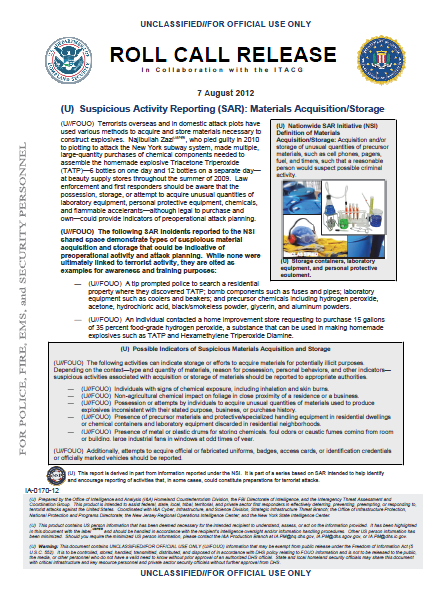ROLL CALL RELEASE
- 1 page
- For Official Use Only
- August 7, 2012
(U//FOUO) Terrorists overseas and in domestic attack plots have used various methods to acquire and store materials necessary to construct explosives. Najibullah Zazi, who pled guilty in 2010 to plotting to attack the New York subway system, made multiple, large-quantity purchases of chemical components needed to assemble the homemade explosive Triacetone Triperoxide (TATP)—6 bottles on one day and 12 bottles on a separate day—at beauty supply stores throughout the summer of 2009. Law enforcement and first responders should be aware that the possession, storage, or attempt to acquire unusual quantities of laboratory equipment, personal protective equipment, chemicals, and flammable accelerants—although legal to purchase and own—could provide indicators of preoperational attack planning.
(U//FOUO) The following SAR incidents reported to the NSI shared space demonstrate types of suspicious material acquisition and storage that could be indicative of preoperational activity and attack planning. While none were ultimately linked to terrorist activity, they are cited as examples for awareness and training purposes:
— (U//FOUO) A tip prompted police to search a residential property where they discovered TATP; bomb components such as fuses and pipes; laboratory equipment such as coolers and beakers; and precursor chemicals including hydrogen peroxide, acetone, hydrochloric acid, black/smokeless powder, glycerin, and aluminum powders.
— (U//FOUO) An individual contacted a home improvement store requesting to purchase 15 gallons of 35 percent food-grade hydrogen peroxide, a substance that can be used in making homemade explosives such as TATP and Hexamethylene Triperoxide Diamine.(U) Possible Indicators of Suspicious Materials Acquisition and Storage
(U//FOUO) The following activities can indicate storage or efforts to acquire materials for potentially illicit purposes. Depending on the context—type and quantity of materials, reason for possession, personal behaviors, and other indicators— suspicious activities associated with acquisition or storage of materials should be reported to appropriate authorities.
— (U//FOUO) Individuals with signs of chemical exposure, including inhalation and skin burns.
— (U//FOUO) Non-agricultural chemical impact on foliage in close proximity of a residence or a business.
— (U//FOUO) Possession or attempts by individuals to acquire unusual quantities of materials used to produce explosives inconsistent with their stated purpose, business, or purchase history.
— (U//FOUO) Presence of precursor materials and protective/specialized handling equipment in residential dwellings or chemical containers and laboratory equipment discarded in residential neighborhoods.
— (U//FOUO) Presence of metal or plastic drums for storing chemicals, foul odors or caustic fumes coming from room or building, large industrial fans in windows at odd times of year.(U//FOUO) Additionally, attempts to acquire official or fabricated uniforms, badges, access cards, or identification credentials or officially marked vehicles should be reported.

